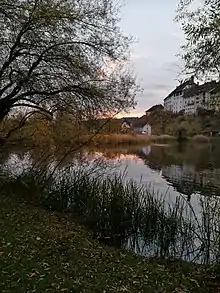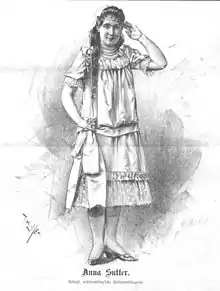Wil
Wil (German pronunciation: [viːl]) is the capital of the Wahlkreis (constituency) of Wil in the canton of St. Gallen in Switzerland.
Wil | |
|---|---|
 View of old town with the Hof in the centre | |
 Coat of arms | |
Location of Wil | |
 Wil  Wil | |
| Coordinates: 47°28′N 9°03′E | |
| Country | Switzerland |
| Canton | St. Gallen |
| District | Wahlkreis Wil |
| Government | |
| • Executive | Stadtrat with 5 members |
| • Mayor | Stadtpräsident (list) Susanne Hartmann CVP/PDC (as of March 2014) |
| • Parliament | Stadtparlament with 45 members |
| Area | |
| • Total | 20.7 km2 (8.0 sq mi) |
| Elevation | 571 m (1,873 ft) |
| Population (31 December 2018)[2] | |
| • Total | 23,955 |
| • Density | 1,200/km2 (3,000/sq mi) |
| Time zone | UTC+01:00 (Central European Time) |
| • Summer (DST) | UTC+02:00 (Central European Summer Time) |
| Postal code(s) | 9500 |
| SFOS number | 3427 |
| Surrounded by | Bronschhofen, Jonschwil, Münchwilen (TG), Rickenbach (TG), Sirnach (TG), Uzwil (SG), Wilen (TG), Zuzwil |
| Twin towns | Dobrzen Wielki (Poland) |
| Website | www SFSO statistics |
Wil is the third largest city in the Canton of St. Gallen, after the city of St. Gallen and Rapperswil-Jona, a twin city that merged in 2006. The municipality of Bronschhofen merged into Wil on 1 January 2013. After the merger the Community Identification Number changed from 3425 to 3427.[3]
In 1984, Wil was awarded the Wakker Prize for the development and preservation of its architectural heritage.[4]
Geography

-LBS_H1-014513.tif.jpg.webp)

Since the merger in 2013, Wil now has an area of 20.82 km2 (8.04 sq mi).[5] Based on the 2004/09 survey, but including the post-merger area, about 50.1% of the total land is used for agricultural purposes, while 18.9% is forested. Of the rest of the land, 30.1% is settled (buildings or roads) and 0.9% is unproductive land. Over the past two decades (1979/85-2004/09) the amount of land that is settled has increased by 111 ha (270 acres) and the agricultural land has decreased by 113 ha (280 acres).[6]
Before the merger, Wil had an area, as of 2006, of 7.6 km2 (2.9 sq mi). Of this area, 32.1% is used for agricultural purposes, while 13.9% is forested. Of the rest of the land, 53.4% is settled (buildings or roads) and the remainder (0.7%) is non-productive (rivers or lakes).[7]
The former municipality of Bronschhofen had an area, as of 2006, of 13.2 km2 (5.1 sq mi). Of this area, 65.3% is used for agricultural purposes, while 22.1% is forested. Of the remaining land, 12% is settled (buildings or roads) and the remainder (0.5%) is non-productive (rivers or lakes).[7] It consisted of the villages of Bronschhofen and Rossrüti as well as the hamlets of Maugwil, Trungen and the pilgrimage site of Dreibrunnen.
Coat of arms
The blazon of the municipal coat of arms is Per pale Argent a Bear rampant Sable langued and in his virility Gules and Sable, a Snail shell Or above a letter W of the First.[8]
Demographics
Wil has a population (as of December 2020) of 24,132.[9] As of 2013, 27.3% of the population are resident foreign nationals. Over the last 3 years (2010-2013) the population has changed at a rate of 3.13%. In 2000, of the foreign population, 272 were from Germany, 776 were from Italy, 1,876 were from ex-Yugoslavia, 135 were from Austria, 309 were from Turkey, and 578 from another country.[10] The birth rate in the municipality, in 2013, was 11.2 while the death rate was 7.5 per thousand residents.[6]
Before the merger, in 2011, Bronschhofen had a population of 4,654.[11]
Most of the population (as of 2000) speaks German (85.1%), with Albanian being the second most common (4.5%) and Italian being the third most common language (3.0%).[7] Of the Swiss national languages (as of 2000), 13,943 speak German, 60 people speak French, 488 people speak Italian, and 26 people speak Romansh.[12]
As of 2013, children and teenagers (0–19 years old) make up 19.7% of the population, while adults (20–64 years old) are 62.6% and seniors (over 64 years old) make up 17.7%.[6]
In 2000 there were 2,829 people (or 17.3% of the population) who were living alone in a private dwelling. There were 4,034 (or 24.6%) people who were part of a couple (married or otherwise committed) without children, and 7,421 (or 45.3%) who were part of a couple with children. There were 954 (or 5.8%) people who lived in single parent home, while there were 79 people who were adult children living with one or both parents, 90 people who lived in a household made up of relatives, 174 who lived in a household made up of unrelated people, and 811 who are either institutionalized or live in another type of collective housing.[12]
In the 2007 federal election the most popular party was the SVP which received 31.7% of the vote. The next three most popular parties were the CVP (21.9%), the SP (14.9%) and the FDP (12.5%).[7]
In Wil about 69.2% of the population (between age 25-64) have completed either non-mandatory upper secondary education or additional higher education (either university or a Fachhochschule).[7] Out of the total population in Wil, as of 2000, the highest education level completed by 3,538 people (21.6% of the population) was Primary, while 6,179 (37.7%) have completed their secondary education, 2,158 (13.2%) have attended a Tertiary school, and 818 (5.0%) are not in school. The remainder did not answer this question.[12]
Heritage sites of national significance

The Baronenhaus at Marktgasse 73, the Dominican Abbey of St. Katharina, the Hof (the former seat of the Prince-abbot) and the pilgrimage church Maria-Hilf at Dreibrunnen are listed as Swiss heritage sites of national significance.[13]
The old city of Wil is designated as part of the Inventory of Swiss Heritage Sites.[14]
Transport
It is a railway node, being located on the train line from Zürich-Winterthur to St. Gallen and connected with lines to Frauenfeld, Weinfelden-Konstanz and Wattwil - Nesslau (Toggenburg) or Rapperswil.
The city is close to the border with the Canton of Thurgau.
Sport
The soccer club FC Wil play in the Swiss Challenge League.
Economy
As of 2012, there were a total of 14,138 people employed in the municipality. Of these, a total of 163 people worked in 54 businesses in the primary economic sector. The secondary sector employed 3,213 workers in 247 separate businesses. Finally, the tertiary sector provided 10,762 jobs in 1,456 businesses. In 2013 a total of 2.0% of the population received social assistance.[6]
As of 2000 there were 3,873 residents who worked in the municipality, while 4,695 residents worked outside Wil and 6,368 people commuted into the municipality for work.[15]
Religion

From the 2000 census, 8,817 or 53.8% are Roman Catholic, while 3,561 or 21.7% belonged to the Swiss Reformed Church. Of the rest of the population, there are 6 individuals (or about 0.04% of the population) who belong to the Christian Catholic faith, there are 473 individuals (or about 2.89% of the population) who belong to the Orthodox Church, and there are 265 individuals (or about 1.62% of the population) who belong to another Christian church. There are 10 individuals (or about 0.06% of the population) who are Jewish, and 1,433 (or about 8.74% of the population) who are Islamic. There are 116 individuals (or about 0.71% of the population) who belong to another church (not listed on the census), 1,138 (or about 6.94% of the population) belong to no church, are agnostic or atheist, and 573 individuals (or about 3.50% of the population) did not answer the question.[12]
Crime
In 2014 the crime rate, of the over 200 crimes listed in the Swiss Criminal Code (running from murder, robbery and assault to accepting bribes and election fraud), in Wil was 62.9 per thousand residents. This rate is about one and a half times greater than the cantonal rate, but very similar to the national rate. During the same period, the rate of drug crimes was 10.2 per thousand residents and the rate of violations of immigration, visa and work permit laws was 3 per thousand. Both of which were very close to the national rate.[16]
Mayor
On 1 January 2013 Susanne Hartmann became the first female mayor not only of Wil-Bronschhofen but in the entire canton of St. Gallen. Hartmann announced her candidacy in April 2012. Despite all forecasts the result of the elections was a landslide victory for Susanne Hartmann.[17][18]
Notable people


- Anna Sutter (1871 in Wil - 1910) operatic soprano
- Nikolaus Senn (1926–2014), former co-director of Schweizerische Bankgesellschaft
- Kurt Widmer (born 1940 in Wil) a baritone and voice teacher, with a focus on concert singing.
- Yvonne Gilli (born 1957) physician and politician, lives in Wil
- Karin Keller-Sutter (born 1963) politician, elected to the Swiss Federal Council in 2018, lived her childhood in Wil
- Renato Tosio (born 1964 in Wil) retired professional ice hockey goaltender
- Alex Zülle (born 1968 in Wil) former professional road bicycle racer.
- Fred W. Mast (born ca.1968 in Wil) professor of Psychology at the University of Bern specializes in mental imagery
- Daniel Imhof (born 1977 in Wil) a Canadian retired soccer player, last played for St. Gallen
- Lukas Reimann (born 1982) a conservative politician, resides in Wil
- Daniel Sereinig (born 1982 in Wil) a footballer with about 250 club caps
- Nicole Graf (born 1985 in Wil) figure skater who competes in ladies singles
- Fabian Schär (born 1991 in Wil) footballer, plays for Newcastle United F.C., nearly 200 club caps and 48 for Switzerland
- Stefan Küng (born 1993 in Wil) world champion in cycling
References
- "Arealstatistik Standard - Gemeinden nach 4 Hauptbereichen". Federal Statistical Office. Retrieved 13 January 2019.
- "Ständige Wohnbevölkerung nach Staatsangehörigkeitskategorie Geschlecht und Gemeinde; Provisorische Jahresergebnisse; 2018". Federal Statistical Office. 9 April 2019. Retrieved 11 April 2019.
- Amtliches Gemeindeverzeichnis der Schweiz published by the Swiss Federal Statistical Office (in German) accessed 2 January 2013
- Wakker Prize Archived 2015-04-11 at the Wayback Machine (in German) accessed 11 May 2009
- Arealstatistik Standard - Gemeindedaten nach 4 Hauptbereichen
- Swiss Federal Statistical Office - Regional portraits accessed 2 May 2016
- Swiss Federal Statistical Office accessed 20-January-2010
- Flags of the World.com accessed 20-January-2010
- "Ständige und nichtständige Wohnbevölkerung nach institutionellen Gliederungen, Geburtsort und Staatsangehörigkeit". bfs.admin.ch (in German). Swiss Federal Statistical Office - STAT-TAB. 31 December 2020. Retrieved 21 September 2021.
- Der Kanton St. Gallen und seine Menschen in Zahlen - Ausgabe 2009 (in German) accessed 30 December 2009
- Canton of St. Gallen Statistics Office Archived 2012-01-22 at the Wayback Machine Wohnbevölkerung (bis 2011) (in German) accessed 1 May 2012
- Canton St. Gallen Statistics-Hauptergebnisse der Volkszählung 2000: Regionen- und Gemeindevergleich-Personen Archived 2009-10-03 at the Wayback Machine (in German) accessed 30 December 2009
- Swiss inventory of cultural property of national and regional significance Archived 2009-05-01 at the Wayback Machine 21.11.2008 version, (in German) accessed 20-Jan-2010
- ISOS site accessed 20-Jan-2010
- St Gallen Canton statistics-Commuters Archived 2009-07-22 at the Wayback Machine (in German) accessed 31 December 2009
- Statistical Atlas of Switzerland accessed 5 April 2016
- "Vorschlag 1 - chez marianne". Archived from the original on 2013-05-08. Retrieved 2022-07-24.
- "Eine Frau mischt Stadt und Kanton auf". 5 November 2012.
External links
- http://www.stadtwil.ch (in German)
- Wilnet - Stadtlexikon der Stadt Wil (in German) city encyclopedia